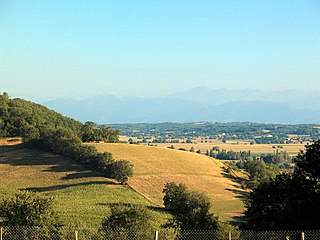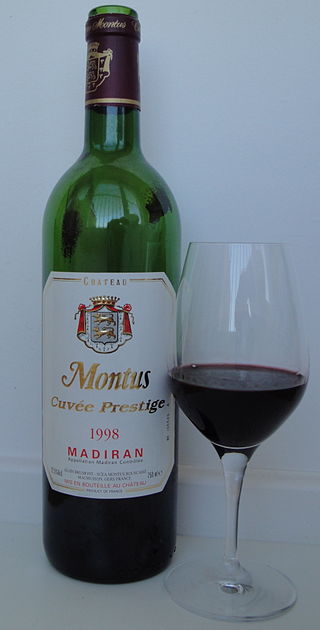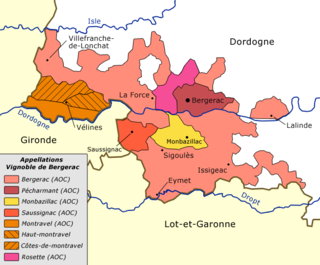
Folle blanche, also known as Picpoule, Gros Plant, and Enrageat blanc, is a wine grape variety from southwest France. It was the traditional grape variety in Cognac and Armagnac production until the 20th century. Folle blanche is an offspring of Gouais blanc, with the other parent so far unidentified.

Vin de pays was a French wine classification that was above the vin de table classification, but below the appellation d'origine contrôlée (AOC) classification and below the former vin délimité de qualité supérieure classification. The vin de pays classification was replaced by the EU indication Indication Géographique Protégée in 2009.

French wine is produced all throughout France, in quantities between 50 and 60 million hectolitres per year, or 7–8 billion bottles. France is one of the largest wine producers in the world, along with Italian, Spanish, and American wine-producing regions. French wine traces its history to the 6th century BCE, with many of France's regions dating their wine-making history to Roman times. The wines produced range from expensive wines sold internationally to modest wines usually only seen within France such as the Margnat wines of the post war period.

Jurançon is a wine region in South West France in the foothills of the Pyrenees, around the commune of Jurançon. It produces a dry white wine and a more sought after sweet white wine. The grape varieties used are Gros Manseng, Petit Manseng and Courbu. The sweet wines develop aromas of tropical fruit such as pineapple and mango. The vines are grown on steep mountain slopes and for the sweet wines the grapes are often hand selected well into October and November to ensure the best noble rot characteristics - although Tim Wildman MW states that noble rot is not the origin of sweetness in these wines.
Madiran is a commune in the Hautes-Pyrénées department in south-western France.

The wine regions of Bordeaux are a large number of wine growing areas, differing widely in size and sometimes overlapping, which lie within the overarching wine region of Bordeaux, centred on the city of Bordeaux and covering the whole area of the Gironde department of Aquitaine.
Côtes du Marmandais is an Appellation d'origine contrôlée (AOC) for wine located in South West France around the commune of Marmande. With its location just southeast of the Entre-Deux-Mers along the banks of the Garonne river, it is a satellite of Bordeaux, but just outside the borders of that region. The region was elevated from Vin Délimité de Qualité Superieure (VDQS) to AOC status in 1990. From the Middle Ages to the 19th century, the wines of the Côtes du Marmandais were widely exported to the Netherlands. The Phylloxera epidemic wiped out most of the vineyards in this area with many farmers switching to other agricultural crops. It was not until the later half of the 20th century that viticulture in the area reaffirmed itself.

Gros Manseng is a white wine grape variety that is grown primarily in South West France, and is part of the Manseng family. It produces dry wines in the Jurançon and Béarn regions of Southwest France. In Gascony it is permitted in the Pacherenc du Vic-Bilh Appellation d'origine contrôlée (AOC), in the Côtes de Gascogne and in the Floc de Gascogne.

Ondenc is a white French wine grape found predominantly in the Gaillac region of southwest France. In the 19th century, it was a popular planting in Bordeaux but fell out of favor following the phylloxera epidemic due to poor yields and sensitivity to grape disease, though is still one of the seven white varieties permitted in Bordeaux. Prior to falling out of favor, vine cuttings were brought from Bordeaux to Australia where the grapes became known under the synonyms of Irvine's White in Victoria and Sercial in South Australia. The Australian grapes weren't identified as Ondenc till 1976 when French ampelographer Paul Truel identified the vine while visiting Australia. Today, the grape is nearly extinct in Australia except for a small amount of plantings in Victoria used in sparkling wine production.

Saint-Mont is a commune in the Gers department in southwestern France.

Côtes de Gascogne is a wine-growing district in Gascony producing principally white wine. It is mainly located in the département of the Gers in the former Midi-Pyrénées region, and it belongs to the wine region South West France. The designation Côtes de Gascogne is used for a Vin de Pays produced in the Armagnac area. The decree of 13 September 1968 created the difference between a Vin de Pays and simpler table wine, the so-called Vin de table. The designation Côtes de Gascogne obliges the producers to respect the stricter rules and production standards, which were adopted with the decree of 25 January 1982.

The Floc de Gascogne is a regional apéritif from the Côtes de Gascogne and Armagnac regions of Sud-Ouest wine region of France. It is a vin de liqueur fortified with armagnac, the local brandy. It has had Appellation d'origine contrôlée status since 1990. Elsewhere in France analogous drinks are made.

Tursan, first a Vin délimité de qualité supérieure (VDQS) for wine in South West France since 1958, has been granted AOC status in 2011.

Madiran wine is produced around the village of Madiran in Gascony under three Appellations d'Origine Contrôlées (AOCs): Madiran for red wines and Pacherenc du Vic-Bilh and Pacherenc du Vic-Bilh Sec for white wines. The production area for Madiran wine is spread over three départments – Gers, Hautes-Pyrénées and Pyrénées-Atlantiques – and is a part of the South West France wine region. There are 1,300 hectares of Madiran vineyards.
Arrufiac is a white French wine grape variety that is primarily planted in the Gascony region of South West France. It is a secondary grape in the wines from the Pacherenc du Vic-Bilh Appellation d'origine contrôlée (AOC). While the grape has had a long history being blended with Petit Courbu in Gascon wines, it has only recently experienced a resurgence of interest in the late 20th century following the release of white blends from Andrė Dubosc of Producteurs Plaimont, one of the region's largest co-operative wineries, in the 1980s.

The Bergerac wine-growing region, a subregion of South West France around the town of Bergerac in the Dordogne department, comprises 93 communes. Its boundaries correspond more or less with those of the Arrondissement of Bergerac, immediately east of the Bordeaux wine region. 1,200 wine-growers cultivate an area of 12,000 hectares. The Bergerac area contains 13 Appellations d'origine contrôlées (AOCs) for red, white and rosé wines.

Côtes de Duras is an Appellation d'Origine Contrôlée (AOC) for red and white wines in South West France. Côtes de Duras is located in the department of Lot-et-Garonne, and is located immediately adjacent to the Bordeaux wine region, which is restricted to the Gironde department, as an extension of Bordeaux immediately to the east of the departmental border.

Béarn is an Appellation d'Origine Contrôlée (AOC) for wine in South West France. It is located in the area of intersection of three French departments: Pyrénées-Atlantiques, Hautes-Pyrénées and Gers; and two regions: Aquitaine and Midi-Pyrénées. Some vineyards in the area of the Jurançon AOC can also produce red Béarn wine, and some in the area of the Madiran AOC may produce a rosé Béarn. Wines made in the village of Bellocq also carry the appellation Béarn-Bellocq.

The cuisine of Gascony is one of the pillars of French cuisine. Its originality stems from its use of regional products and from an age-old tradition, typical of the Aquitane and the Midi-Pyrenees, of cooking in fat, in particular goose and duck fat, whereas the cuisine of the south of France favours frying in oil and the cuisine of Normandy contains more dishes that are simmered or cooked in butter. The long life expectancy of Gascons, despite a rich diet, is a classic example of the French paradox.















